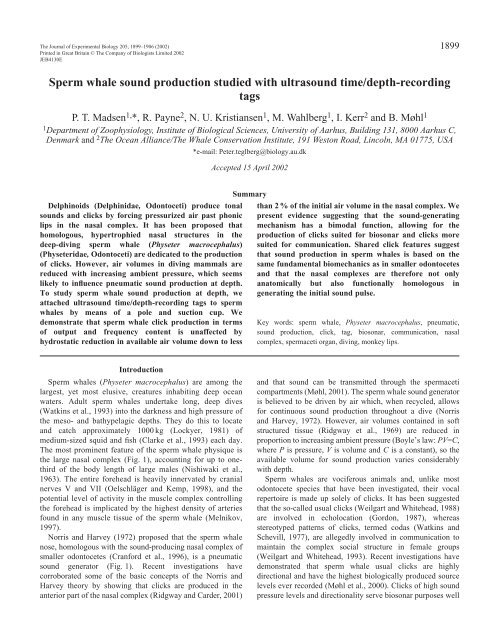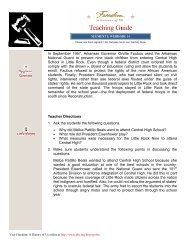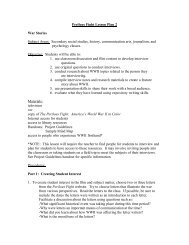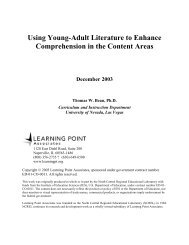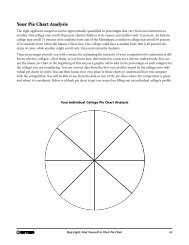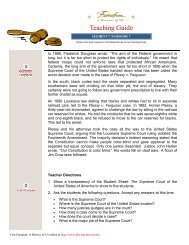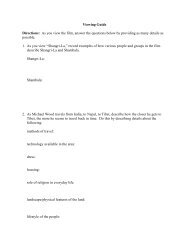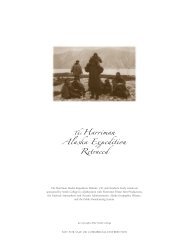Sperm whale sound production - The Journal of Experimental ...
Sperm whale sound production - The Journal of Experimental ...
Sperm whale sound production - The Journal of Experimental ...
Create successful ePaper yourself
Turn your PDF publications into a flip-book with our unique Google optimized e-Paper software.
<strong>The</strong> <strong>Journal</strong> <strong>of</strong> <strong>Experimental</strong> Biology 205, 1899–1906 (2002)<br />
Printed in Great Britain © <strong>The</strong> Company <strong>of</strong> Biologists Limited 2002<br />
JEB4130E<br />
1899<br />
<strong>Sperm</strong> <strong>whale</strong> <strong>sound</strong> <strong>production</strong> studied with ultra<strong>sound</strong> time/depth-recording<br />
tags<br />
P. T. Madsen 1, *, R. Payne 2 , N. U. Kristiansen 1 , M. Wahlberg 1 , I. Kerr 2 and B. Møhl 1<br />
1 Department <strong>of</strong> Zoophysiology, Institute <strong>of</strong> Biological Sciences, University <strong>of</strong> Aarhus, Building 131, 8000 Aarhus C,<br />
Denmark and 2 <strong>The</strong> Ocean Alliance/<strong>The</strong> Whale Conservation Institute, 191 Weston Road, Lincoln, MA 01775, USA<br />
*e-mail: Peter.teglberg@biology.au.dk<br />
Accepted 15 April 2002<br />
Delphinoids (Delphinidae, Odontoceti) produce tonal<br />
<strong>sound</strong>s and clicks by forcing pressurized air past phonic<br />
lips in the nasal complex. It has been proposed that<br />
homologous, hypertrophied nasal structures in the<br />
deep-diving sperm <strong>whale</strong> (Physeter macrocephalus)<br />
(Physeteridae, Odontoceti) are dedicated to the <strong>production</strong><br />
<strong>of</strong> clicks. However, air volumes in diving mammals are<br />
reduced with increasing ambient pressure, which seems<br />
likely to influence pneumatic <strong>sound</strong> <strong>production</strong> at depth.<br />
To study sperm <strong>whale</strong> <strong>sound</strong> <strong>production</strong> at depth, we<br />
attached ultra<strong>sound</strong> time/depth-recording tags to sperm<br />
<strong>whale</strong>s by means <strong>of</strong> a pole and suction cup. We<br />
demonstrate that sperm <strong>whale</strong> click <strong>production</strong> in terms<br />
<strong>of</strong> output and frequency content is unaffected by<br />
hydrostatic reduction in available air volume down to less<br />
Summary<br />
than 2 % <strong>of</strong> the initial air volume in the nasal complex. We<br />
present evidence suggesting that the <strong>sound</strong>-generating<br />
mechanism has a bimodal function, allowing for the<br />
<strong>production</strong> <strong>of</strong> clicks suited for biosonar and clicks more<br />
suited for communication. Shared click features suggest<br />
that <strong>sound</strong> <strong>production</strong> in sperm <strong>whale</strong>s is based on the<br />
same fundamental biomechanics as in smaller odontocetes<br />
and that the nasal complexes are therefore not only<br />
anatomically but also functionally homologous in<br />
generating the initial <strong>sound</strong> pulse.<br />
Key words: sperm <strong>whale</strong>, Physeter macrocephalus, pneumatic,<br />
<strong>sound</strong> <strong>production</strong>, click, tag, biosonar, communication, nasal<br />
complex, spermaceti organ, diving, monkey lips.<br />
Introduction<br />
<strong>Sperm</strong> <strong>whale</strong>s (Physeter macrocephalus) are among the<br />
largest, yet most elusive, creatures inhabiting deep ocean<br />
waters. Adult sperm <strong>whale</strong>s undertake long, deep dives<br />
(Watkins et al., 1993) into the darkness and high pressure <strong>of</strong><br />
the meso- and bathypelagic depths. <strong>The</strong>y do this to locate<br />
and catch approximately 1000 kg (Lockyer, 1981) <strong>of</strong><br />
medium-sized squid and fish (Clarke et al., 1993) each day.<br />
<strong>The</strong> most prominent feature <strong>of</strong> the sperm <strong>whale</strong> physique is<br />
the large nasal complex (Fig. 1), accounting for up to onethird<br />
<strong>of</strong> the body length <strong>of</strong> large males (Nishiwaki et al.,<br />
1963). <strong>The</strong> entire forehead is heavily innervated by cranial<br />
nerves V and VII (Oelschläger and Kemp, 1998), and the<br />
potential level <strong>of</strong> activity in the muscle complex controlling<br />
the forehead is implicated by the highest density <strong>of</strong> arteries<br />
found in any muscle tissue <strong>of</strong> the sperm <strong>whale</strong> (Melnikov,<br />
1997).<br />
Norris and Harvey (1972) proposed that the sperm <strong>whale</strong><br />
nose, homologous with the <strong>sound</strong>-producing nasal complex <strong>of</strong><br />
smaller odontocetes (Cranford et al., 1996), is a pneumatic<br />
<strong>sound</strong> generator (Fig. 1). Recent investigations have<br />
corroborated some <strong>of</strong> the basic concepts <strong>of</strong> the Norris and<br />
Harvey theory by showing that clicks are produced in the<br />
anterior part <strong>of</strong> the nasal complex (Ridgway and Carder, 2001)<br />
and that <strong>sound</strong> can be transmitted through the spermaceti<br />
compartments (Møhl, 2001). <strong>The</strong> sperm <strong>whale</strong> <strong>sound</strong> generator<br />
is believed to be driven by air which, when recycled, allows<br />
for continuous <strong>sound</strong> <strong>production</strong> throughout a dive (Norris<br />
and Harvey, 1972). However, air volumes contained in s<strong>of</strong>t<br />
structured tissue (Ridgway et al., 1969) are reduced in<br />
proportion to increasing ambient pressure (Boyle’s law: PV=C,<br />
where P is pressure, V is volume and C is a constant), so the<br />
available volume for <strong>sound</strong> <strong>production</strong> varies considerably<br />
with depth.<br />
<strong>Sperm</strong> <strong>whale</strong>s are vociferous animals and, unlike most<br />
odontocete species that have been investigated, their vocal<br />
repertoire is made up solely <strong>of</strong> clicks. It has been suggested<br />
that the so-called usual clicks (Weilgart and Whitehead, 1988)<br />
are involved in echolocation (Gordon, 1987), whereas<br />
stereotyped patterns <strong>of</strong> clicks, termed codas (Watkins and<br />
Schevill, 1977), are allegedly involved in communication to<br />
maintain the complex social structure in female groups<br />
(Weilgart and Whitehead, 1993). Recent investigations have<br />
demonstrated that sperm <strong>whale</strong> usual clicks are highly<br />
directional and have the highest biologically produced source<br />
levels ever recorded (Møhl et al., 2000). Clicks <strong>of</strong> high <strong>sound</strong><br />
pressure levels and directionality serve biosonar purposes well
1900<br />
P. T. Madsen and others<br />
Fig. 1. Schematic view <strong>of</strong> the head <strong>of</strong> a 10 m long sperm <strong>whale</strong><br />
(Physeter macrocephalus) showing placement <strong>of</strong> the tag. B,<br />
brain; Bl, blow hole; Di, distal air sac; Fr, frontal air sac; Ju,<br />
junk; Ln, left naris; Ma, mandible; Mo, monkey lips/museau de<br />
singe; MT, muscle/tendon layer; Ro, rostrum; Rn, right naris;<br />
So, spermaceti organ; T, tag. <strong>Sperm</strong>aceti oil is contained in the<br />
spermaceti organ and in the spermaceti bodies <strong>of</strong> the junk. <strong>The</strong><br />
muscle/tendon layer covers the entire dorso-lateral part <strong>of</strong> the<br />
spermaceti organ and inserts into the connective tissue around<br />
and in front <strong>of</strong> the monkey lips. Arrows indicate the <strong>sound</strong> path<br />
according to the modified (by Møhl, 2001) theory <strong>of</strong> Norris<br />
and Harvey (1972): it is proposed that air forced from the right<br />
naris through the monkey lips generates the <strong>sound</strong> pulse. <strong>The</strong><br />
majority <strong>of</strong> the <strong>sound</strong> energy is due to the geometry <strong>of</strong> the lips<br />
and the reflective properties <strong>of</strong> the distal air sac, directed<br />
backwards into the spermaceti organ. When it reaches the<br />
frontal air sac, the <strong>sound</strong> pulse is reflected into the junk<br />
complex and directed into the water in front <strong>of</strong> the <strong>whale</strong>. <strong>The</strong><br />
multi-pulse structure <strong>of</strong> sperm <strong>whale</strong> clicks appears to be generated by partial interception by the distal air sac <strong>of</strong> the forward-propagating<br />
pulse, leading to another round trip during which another fraction <strong>of</strong> the <strong>sound</strong> energy is intercepted by the distal air sac and so on.<br />
(Au, 1993) but seem a poor choice for communication because<br />
directionality reduces the communicative space.<br />
Because <strong>of</strong> the directional properties <strong>of</strong> sperm <strong>whale</strong> usual<br />
clicks, far-field recordings cannot quantify changes in the<br />
acoustic output <strong>of</strong> the <strong>sound</strong> generator since scanning<br />
movements <strong>of</strong> a directional source rather than output<br />
modulations may be the cause <strong>of</strong> the observed changes. By<br />
placing a calibrated recording unit in a fixed position on a<br />
phonating sperm <strong>whale</strong>, directional and/or hydro-acoustic<br />
effects on the recorded signals can be ruled out, and any<br />
observed changes will reflect actual changes in the acoustic<br />
output <strong>of</strong> the <strong>sound</strong> generator. Sound-recording tags have<br />
successfully been placed on elephant seals (Fletcher et al.,<br />
1996; Burgess et al., 1998) and sperm <strong>whale</strong>s (Malak<strong>of</strong>f, 2001)<br />
to register levels <strong>of</strong> low-frequency noise impinging on the<br />
tagged animal and how the behaviour <strong>of</strong> the animal is affected.<br />
Of interest in the present study are the acoustics and<br />
biomechanics <strong>of</strong> the sperm <strong>whale</strong> <strong>sound</strong> generator. To study<br />
these, we developed a tag that allows for absolute <strong>sound</strong><br />
pressure recordings <strong>of</strong> clicks for 30 min and combination <strong>of</strong><br />
these data with the real time and depth <strong>of</strong> the <strong>whale</strong>.<br />
Here, we report that sperm <strong>whale</strong>s can maintain and regulate<br />
acoustic outputs even when they have a very limited volume<br />
<strong>of</strong> air in the nasal complex. We also present evidence to<br />
suggest that the <strong>sound</strong>-generating mechanism has a bimodal<br />
function that allows for the <strong>production</strong> <strong>of</strong> clicks suited for<br />
biosonar and clicks more suited for communication.<br />
Materials and methods<br />
Habitat<br />
Investigations were carried out in the Bismarck Sea <strong>of</strong>f<br />
Papua New Guinea from the research vessel R/V Odyssey in<br />
May 2001. <strong>The</strong> voyage <strong>of</strong> the R/V Odyssey is a multiyear,<br />
collaborative program designed to gather the first-ever<br />
coherent set <strong>of</strong> baseline data on levels <strong>of</strong> synthetic<br />
contaminants throughout the world’s oceans and to measure<br />
the effects <strong>of</strong> these substances on ocean life. <strong>The</strong> voyage is<br />
coordinated by <strong>The</strong> Ocean Alliance/<strong>The</strong> Whale Conservation<br />
Institute. <strong>The</strong> Bismarck Sea (centre 5°S, 150°E) is an important<br />
habitat for sperm <strong>whale</strong>s and other odontocetes. Several<br />
mother/calf pairs and sexually mature males have been<br />
observed, indicating that the area is a breeding ground for<br />
sperm <strong>whale</strong>s (Physeter macrocephalus). In this study, only<br />
adult or semi-adult specimens were approached for tagging.<br />
<strong>The</strong> tag<br />
<strong>The</strong> tag was based on an aluminium housing (diameter<br />
100 mm) with a Syntactic foam tail (MacArtney, Denmark)<br />
pressure-tested to a depth <strong>of</strong> 1100 m. Signals from a custombuilt<br />
hydrophone were highpass-filtered (–12 dB per octave,<br />
fundamental frequency 1 kHz) and relayed, via an adjustable<br />
gain/anti-alias filter unit, to a 12-bit ADC (Analog Devices:<br />
AD7870) and µcontroller (Maxim Integrated Products, Inc.<br />
DS5000T) unit (sampling at 62.5 kHz) writing acoustic, realtime<br />
and depth data to a 192 Mb Sandisk Compact flash card.<br />
<strong>The</strong> hydrophone was calibrated relative to a B&K 8101<br />
hydrophone in an anechoic tank before and after deployment.<br />
Sound recording (bandwidth 30 kHz) was triggered at a depth<br />
<strong>of</strong> 20 m. <strong>The</strong> depth transducer was a calibrated Keller PA-7-<br />
200 transducer providing depth information in the range<br />
0–1500 m with an accuracy <strong>of</strong> 3 m. <strong>The</strong> suction cup (diameter<br />
25 cm) was moulded from Wacker silicone (Elastosil M-4440)<br />
in a custom-built cast.<br />
Attachment and retrieval<br />
<strong>The</strong> tag was deployed with a 4.5 m pole from a special boom<br />
rigged on the R/V Odyssey; the tag was attached to the <strong>whale</strong><br />
with a suction cup (Fig. 2). <strong>The</strong> <strong>whale</strong>s were approached from<br />
behind, and the ship drifted the last 30–50 m with the engine<br />
turned <strong>of</strong>f to make a silent approach. Four <strong>whale</strong>s were<br />
successfully tagged in 45 trials. After detachment, the tag was
<strong>Sperm</strong> <strong>whale</strong> <strong>sound</strong> <strong>production</strong><br />
1901<br />
0<br />
100<br />
–200<br />
% <strong>of</strong> initial<br />
air volume<br />
10<br />
Depth (m)<br />
–400<br />
1<br />
0 200 400 600<br />
Depth (m)<br />
–600<br />
–800<br />
0 5 10 15 20 25 30<br />
Time (min)<br />
Fig. 2. Attachment <strong>of</strong> the tag by means <strong>of</strong> a pole and suction cup.<br />
Tagger, J. Jones; photograph by C. Johnson/Ocean Alliance.<br />
retrieved by taking a bearing with four-element Yagi antennae<br />
(Televilt, Y-4FL) to signals from a Telonic MOD-305, Cast<br />
3C, transmitter integrated in the Syntactic foam tail. A B&K<br />
8101 hydrophone was deployed to record the far-field<br />
signatures <strong>of</strong> the clicks recorded by the tag. Signals from the<br />
B&K 8101 hydrophone were recorded on a Sony TCD-D8<br />
DAT recorder. This recording chain had a flat (within 2 dB)<br />
frequency response from 0.01 kHz to 22 kHz. From video<br />
footage <strong>of</strong> the tag attachments, it was possible to calculate the<br />
size <strong>of</strong> the <strong>whale</strong> from the diameter <strong>of</strong> the attached suction cup<br />
(Whitehead and Payne, 1981).<br />
Analysis<br />
Data were transferred via the Flash card and a PCMCIA slot<br />
to a laptop. <strong>The</strong> anti-alias filter was compensated for during<br />
analysis, giving a flat frequency response <strong>of</strong> the tag in the range<br />
0.1–30 kHz. Analysis was performed with Cool edit 2000<br />
(Syntrilium) and routines written in Matlab 5.3 (MathWorks).<br />
Inter-click intervals (ICI) were derived with a peak detector<br />
looking for suprathreshold values <strong>of</strong> the envelope <strong>of</strong> the<br />
recorded signals. <strong>The</strong> spectral content <strong>of</strong> the clicks was<br />
described by the end points <strong>of</strong> the –10 dB bandwidth. Centroid<br />
frequency was derived as the frequency dividing the spectrum<br />
into halves <strong>of</strong> equal energy. <strong>The</strong> duration <strong>of</strong> a click was defined<br />
as the interval between the –10 dB points relative to the peak<br />
<strong>of</strong> the envelope function.<br />
Results<br />
Four <strong>whale</strong>s were tagged in 45 attempts. Here, we present<br />
data mainly from the fourth tagging event since that tag<br />
gathered acoustic data from an entire dive cycle. Tag IV was<br />
Fig. 3. Dive pr<strong>of</strong>ile <strong>of</strong> a tagged sperm <strong>whale</strong>. Circles indicates the<br />
<strong>production</strong> <strong>of</strong> coda clicks and triangles the <strong>production</strong> <strong>of</strong> usual<br />
clicks. Note that the <strong>whale</strong> stops clicking during most <strong>of</strong> the ascent.<br />
Water depth is 940 m. Total number <strong>of</strong> coda clicks, 54. Total number<br />
<strong>of</strong> usual clicks, 1804. Inset, reduction in air volume as a function <strong>of</strong><br />
depth (PV=C, where P is pressure, V is volume and C is a constant).<br />
Note the logarithmic scale on the ordinate.<br />
placed behind the crest <strong>of</strong> the skull (see Fig. 1). <strong>The</strong> <strong>whale</strong><br />
initiated a deep dive (Fig. 3) 2 min after attachment <strong>of</strong> the tag.<br />
At a depth <strong>of</strong> 50 m, the <strong>whale</strong> started to produce codas. After<br />
emitting 11 codas during descent to 265 m, the <strong>whale</strong> switched<br />
to the <strong>production</strong> <strong>of</strong> usual clicks after 15 s <strong>of</strong> silence. When the<br />
air volumes are pressurized during descent, the volume <strong>of</strong> air<br />
will be reduced in accord with Boyle’s law, and the density <strong>of</strong><br />
the air will increase, whereas its viscosity will remain largely<br />
unchanged. When the <strong>whale</strong> started to produce coda clicks at<br />
a depth <strong>of</strong> 50 m, it would have had less than 20 % <strong>of</strong> its initial<br />
air volume; it would have had less than 4 % when it switched<br />
to producing usual clicks at a depth <strong>of</strong> 265 m (Boyle’s law)<br />
(Fig. 3 inset). Of the 1804 usual clicks, 80 % were made at a<br />
depth <strong>of</strong> more than 600 m and thus were produced by the <strong>whale</strong><br />
when it had less than 2 % <strong>of</strong> the initial air volume available to<br />
it for <strong>sound</strong> <strong>production</strong>. After 23 min <strong>of</strong> submergence, the<br />
<strong>whale</strong> stopped clicking and remained silent during ascent.<br />
Descent rate was 60 m min –1 and ascent rate 75 m min –1<br />
(Fig. 3).<br />
<strong>The</strong> <strong>production</strong> <strong>of</strong> usual clicks is initiated with an ICI <strong>of</strong><br />
approximately 1 s, but as the <strong>whale</strong> approaches the depth at<br />
which its dive levels <strong>of</strong>f, the ICIs drop to a stable 0.5 s (Fig. 4).<br />
During descent, the ICIs decrease by 100–200 ms and<br />
subsequently increase almost back to the starting level in 3–4<br />
repeated cycles (Fig. 4). Click trains are interrupted by periods<br />
<strong>of</strong> silence lasting 5–30 s.<br />
Recorded levels <strong>of</strong> all 1804 usual clicks are plotted in Fig. 5.<br />
<strong>The</strong> recorded levels <strong>of</strong> the first usual clicks are less than 170 dB
1902<br />
P. T. Madsen and others<br />
Depth (m)<br />
0<br />
–200<br />
–400<br />
–600<br />
–800<br />
0<br />
0 500 1000 1500 2000<br />
Click number<br />
Fig. 4. Inter-click interval (open circles) and dive depth as a function<br />
<strong>of</strong> click number during each <strong>of</strong> the 1804 usual clicks produced<br />
during the dive pr<strong>of</strong>iled in Fig. 3.<br />
re. 1 µPa (peak to peak, pp), and the amplitudes <strong>of</strong> the<br />
following clicks increase to approximately 178 dB re. 1 µPa<br />
(pp). <strong>The</strong> acoustic output is independent <strong>of</strong> depth within a<br />
20 dB range from 170 to 190 dB re. 1 µPa (pp) (Fig. 5).<br />
As seen from the data presented in Table 1, there are marked<br />
differences between the waveforms <strong>of</strong> usual clicks and coda<br />
clicks. <strong>The</strong> coda clicks (N=54) have a mean recorded level <strong>of</strong><br />
165±5 dB re. 1 µPa (pp), which is significantly lower than<br />
the mean recorded level <strong>of</strong> usual clicks (N=1804) <strong>of</strong><br />
178±4 dB re. 1 µPa (pp) (P
<strong>Sperm</strong> <strong>whale</strong> <strong>sound</strong> <strong>production</strong><br />
1903<br />
Table 1. Characteristics <strong>of</strong> usual clicks and coda clicks recorded with the tag<br />
Mean RL RL range Duration Centroid frequency –10 dB BW<br />
Click type (dB re. 1 µPa pp) (dB) (µs) (kHz) (kHz)<br />
Usual click 178 25 100 8–26 10–15<br />
Coda click 165 10 300 7–9 3–4<br />
Duration denotes the interval between –10 dB points <strong>of</strong> the envelope <strong>of</strong> the initial (p 0) pulse.<br />
BW, bandwidth; RL, recorded <strong>sound</strong> level.<br />
the acoustic output (recorded level) and centroid frequency<br />
(Fig. 7).<br />
Discussion<br />
With a body length <strong>of</strong> 10 m and an estimated mass <strong>of</strong> 9800 kg<br />
(Lockyer, 1981), the <strong>whale</strong> tagged with tag IV probably<br />
contained some 200 l <strong>of</strong> air after inhalation while at the surface<br />
(inferred from Clarke, 1978). If the lungs <strong>of</strong> a sperm <strong>whale</strong><br />
collapse (Ridgway, 1971) as they do in smaller odontocetes<br />
(Ridgway et al., 1969), the <strong>whale</strong> would have had, at most, 3.5 l<br />
<strong>of</strong> air available to it for <strong>sound</strong> <strong>production</strong> at a depth <strong>of</strong> 600 m.<br />
Thus, sperm <strong>whale</strong>s recycle the air after each click or group <strong>of</strong><br />
clicks (as demonstrated in Tursiops sp.; Dormer, 1979) and/or<br />
use very small volumes <strong>of</strong> air to generate each click.<br />
Considering the highly reduced air volume available for <strong>sound</strong><br />
<strong>production</strong> when the <strong>whale</strong> is at a depth <strong>of</strong> 700 m and that sperm<br />
<strong>whale</strong>s have been reported to phonate at depths <strong>of</strong> more than<br />
2000 m (Whitney, 1968), it is conceivable that air simply is not<br />
involved in sperm <strong>whale</strong> <strong>sound</strong> <strong>production</strong>. That view,<br />
however, is not supported by experimental data on <strong>sound</strong><br />
<strong>production</strong> in the homologous structures <strong>of</strong> smaller odontocetes<br />
(Ridgway and Carder, 1988) or by anatomical evidence<br />
Centroid frequency (kHz)<br />
30<br />
25<br />
20<br />
15<br />
10<br />
5<br />
165 170 175 180 185 190 195<br />
Recorded level (dB re.1 µPa peak to peak)<br />
Fig. 7. Centroid frequency and recorded <strong>sound</strong> level. Centroid<br />
frequency (the frequency that divides the spectrum in two parts <strong>of</strong><br />
equal energy) as a function <strong>of</strong> recorded level (1 dB bins). <strong>The</strong> solid<br />
line is the linear regression curve fitted to the data (r=0.70, P
1904 P. T. Madsen and others<br />
consequently towards the recording tag. When generating coda<br />
clicks, a large fraction <strong>of</strong> the returning pulse (p 1 ) from the<br />
frontal sac appears to be intercepted by the distal air sac and<br />
contained in the nasal complex for further round trips, thereby<br />
giving rise to a large number <strong>of</strong> pulses with small decay rates<br />
within each coda click. We propose that these two different<br />
ways <strong>of</strong> handling the initial <strong>sound</strong> pulse represent a bimodal<br />
generation <strong>of</strong> clicks depending on whether they are intended<br />
by the <strong>whale</strong> for use in biosonar or for communication. In usual<br />
clicks, most <strong>of</strong> the energy is put into a single pulse, directed<br />
into the water in front <strong>of</strong> the <strong>whale</strong> after traversing the<br />
spermaceti complex twice. In coda clicks, the energy is<br />
recycled in the nasal complex by multiple reflections that seem<br />
to result in less-directional clicks that are better suited for<br />
communication. In addition to the inferred low directionality,<br />
the narrow-band nature, longer pulse duration and low decay<br />
rate <strong>of</strong> coda clicks may <strong>of</strong>fer useful information about the<br />
transmitter to conspecifics. We suggest that the initial pulse <strong>of</strong><br />
the two click types is generated in the same way and that the<br />
marked differences between coda clicks and usual clicks are<br />
caused by different <strong>sound</strong> propagation in the nasal complex.<br />
<strong>The</strong> difference in click structure and the inferred difference in<br />
directionality between coda clicks and usual clicks may also<br />
explain in part the substantial discrepancy between reports <strong>of</strong><br />
low directionality in clicks from coda-producing sperm <strong>whale</strong>s<br />
(Watkins, 1980) and the high directionality observed in usual<br />
clicks from foraging male sperm <strong>whale</strong>s (Møhl et al., 2000).<br />
If the distinct multipulse structure <strong>of</strong> the coda clicks is<br />
generated by repetitive reflections on the air sacs, it may<br />
explain why coda clicks are produced in the shallow part <strong>of</strong><br />
the dive cycle when more than 4 % <strong>of</strong> the initial air volume is<br />
still present. It is possible that a certain air volume is needed<br />
to maintain the <strong>production</strong> <strong>of</strong> coda clicks and that sperm<br />
<strong>whale</strong>s are accordingly limited by depth in coda <strong>production</strong>.<br />
However, the fact that the <strong>whale</strong> switched from the <strong>production</strong><br />
<strong>of</strong> coda clicks to usual clicks within 10 s, at a depth <strong>of</strong> 265 m<br />
suggests that shifts between the two modes <strong>of</strong> click generation<br />
are not determined solely by the available air volume. It is<br />
feasible that, during the formation <strong>of</strong> a usual click, muscle<br />
action in the complex muscle/tendon system covering the<br />
dorso-lateral part <strong>of</strong> the spermaceti organ could be changing<br />
the conformation <strong>of</strong> the <strong>sound</strong>-transmitting structures and<br />
the distal air sac, thereby causing most <strong>of</strong> the energy to be<br />
projected forwards into the water after one round trip through<br />
the spermaceti complex. On the basis <strong>of</strong> observations <strong>of</strong><br />
several other pulsed <strong>sound</strong> types from sperm <strong>whale</strong>s (Gordon,<br />
1987; Weilgart and Whitehead, 1988), the possibility that the<br />
sperm <strong>whale</strong> <strong>sound</strong> generator may have additional modes from<br />
the two deduced from this study cannot be excluded.<br />
<strong>The</strong> far-field signature <strong>of</strong> the clicks revealed a different<br />
waveform and emphasis at lower frequencies compared with<br />
the tag recording. <strong>The</strong> waveform differences between the nearfield<br />
(the tag) and the far field cannot be explained solely by<br />
surface reflections and hydrodynamic effects because the<br />
decay rate <strong>of</strong> the usual clicks was lower in the far field than<br />
when recorded in the near field from the crest <strong>of</strong> the skull. It<br />
is tempting to suggest that the lower centroid frequency<br />
observed in the far field relates to lowpass-filtering <strong>of</strong> the clicks<br />
by frequency-dependent absorption. However, considering the<br />
physical limits <strong>of</strong> the range between the tagged animal and the<br />
research vessel during 10–20 min <strong>of</strong> swimming (1–5 m s –1 ),<br />
frequency-dependent absorption in the relevant frequency<br />
range <strong>of</strong> sperm <strong>whale</strong> clicks cannot account entirely for the<br />
observed changes (Urick, 1983). It appears that the main<br />
contributing factor to the waveform and frequency differences<br />
is the directional effects <strong>of</strong> the sperm <strong>whale</strong> <strong>sound</strong> generator.<br />
<strong>The</strong> Gordon equation (Gordon, 1991) describes the<br />
relationship between IPI and the size <strong>of</strong> a <strong>whale</strong>. With an IPI<br />
<strong>of</strong> 3.4 ms, the Gordon equation predicts a body length <strong>of</strong> 9.8 m,<br />
which matches the visual estimate <strong>of</strong> 10 m from video<br />
recordings <strong>of</strong> the <strong>whale</strong> and the tag. Consequently, the data<br />
presented here lend weight to the Gordon equation as a reliable<br />
acoustic means <strong>of</strong> measuring the size <strong>of</strong> sperm <strong>whale</strong>s from<br />
their clicks.<br />
<strong>The</strong> inter-pulse interval (IPI) is 3.4 ms in both click types<br />
and constant throughout the dive. Clarke (1970) has proposed<br />
that the nasal complex <strong>of</strong> the sperm <strong>whale</strong> is a buoyancy<br />
regulator that facilitates descent and ascent during dives by<br />
cooling and heating the spermaceti oil. Assuming a pressure<br />
range <strong>of</strong> 7000 kPa (70 atmospheres) (0–700 m depth) and a<br />
temperature difference <strong>of</strong> 22–37 °C, it can be calculated that<br />
the <strong>sound</strong> speed would differ by 7 % between the start and the<br />
deepest point <strong>of</strong> a dive (on the basis <strong>of</strong> data from Goold et al.,<br />
1996). In a sperm <strong>whale</strong> with an estimated two-way <strong>sound</strong><br />
travel path <strong>of</strong> 4.7 m (Fig. 1), such differences in <strong>sound</strong> speed<br />
would change the IPI by more than 200 µs during a dive to<br />
700 m. We did not observe IPI fluctuations <strong>of</strong> that order <strong>of</strong><br />
magnitude, so the theory (Clarke, 1970) proposing that ascent<br />
and descent <strong>of</strong> sperm <strong>whale</strong>s are assisted by changes in<br />
buoyancy <strong>of</strong> the head due to heating and cooling <strong>of</strong> the<br />
spermaceti oil is not supported.<br />
<strong>The</strong> centroid frequencies <strong>of</strong> the usual clicks vary between 8<br />
and 26 kHz. <strong>The</strong>se values are consistent with previous reports<br />
on the frequency content <strong>of</strong> sperm <strong>whale</strong> clicks (Watkins,<br />
1980; Madsen and Møhl, 2000). It is, however, surprising that<br />
centroid frequencies above 10 kHz can be found in usual clicks<br />
recorded from what is believed to be 180 ° <strong>of</strong>f the acoustic<br />
axis <strong>of</strong> the <strong>sound</strong> generator (Møhl et al., 2000). It can be<br />
conjectured that the high centroid frequencies recorded from<br />
the crest <strong>of</strong> the skull are due to near-field phenomena and the<br />
peculiar <strong>sound</strong> transmission in the sperm <strong>whale</strong> nasal complex,<br />
where the bulk <strong>of</strong> the initial pulse is directed backwards into<br />
the spermaceti organ by the distal sac and anatomy <strong>of</strong> the<br />
monkey lips. This problem calls for further investigations.<br />
<strong>The</strong>re are no apparent correlations between the spectrum <strong>of</strong><br />
the usual clicks and the <strong>whale</strong>’s depth because both high and<br />
low centroid frequencies were recorded from clicks at the<br />
deepest part <strong>of</strong> the dive. This contrasts with investigations<br />
on white <strong>whale</strong> (Delphinapterus leucas) whistles at depth<br />
(Ridgway et al., 2001). Ridgway and co-workers found that the<br />
peak frequency <strong>of</strong> whistle spectra increased with depth and<br />
proposed that this effect is the result <strong>of</strong> increased air density
<strong>Sperm</strong> <strong>whale</strong> <strong>sound</strong> <strong>production</strong><br />
1905<br />
and a reduction in total air volume at depth. <strong>The</strong> absence <strong>of</strong> a<br />
similar effect in sperm <strong>whale</strong> clicks emphasises, in our view,<br />
the difference in how clicks and whistles are generated in the<br />
odontocete nasal complex.<br />
When centroid frequency is plotted against recorded <strong>sound</strong><br />
level (Fig. 7), it appears that there is a positive correlation<br />
between acoustic output and frequency. This correlation should<br />
not be confused with the fact that the on-axis parts <strong>of</strong> the clicks<br />
contain more high-frequency components than the <strong>of</strong>f-axis<br />
parts (Møhl et al., 2000). Investigations on smaller odontocetes<br />
have revealed a positive correlation between acoustic output<br />
and centroid frequency in clicks from D. leucas, P. crassidens<br />
and Tursiops truncatus (Au, 2001). That a similar relationship<br />
has been found in the present study supports the conclusion<br />
that <strong>sound</strong> <strong>production</strong> in sperm <strong>whale</strong>s is based on the same<br />
fundamental biomechanics as in smaller odontocetes and that<br />
the nasal complexes are, therefore, not only anatomically<br />
(Cranford, 1999) but also functionally homologous in<br />
generating the initial <strong>sound</strong> pulse.<br />
In conclusion, sperm <strong>whale</strong> click <strong>production</strong> in terms <strong>of</strong><br />
output and frequency content is unaffected by hydrostatic<br />
reductions in available air volume down to depths <strong>of</strong> at least<br />
700 m. Evidence is presented to suggest that the <strong>sound</strong>generating<br />
mechanism has a bimodal function, allowing for the<br />
<strong>production</strong> <strong>of</strong> clicks suited for biosonar and clicks more suited<br />
for communication. Shared click features suggest that <strong>sound</strong><br />
<strong>production</strong> in sperm <strong>whale</strong>s is based on the same fundamental<br />
biomechanics as in smaller odontocetes. This project has<br />
shown that it is possible to gather information about the<br />
physiology and biomechanics <strong>of</strong> <strong>sound</strong> <strong>production</strong> from freeranging<br />
animals not suited for study in captivity. Together with<br />
other approaches, the development <strong>of</strong> this technique can<br />
provide further insight into the mechanics <strong>of</strong> the largest<br />
biological <strong>sound</strong> generator, the sperm <strong>whale</strong> nose, and may<br />
prove to be heuristic in the development <strong>of</strong> biomimetic <strong>sound</strong><br />
sources in man-made sonars.<br />
We thank M. Bjørn, P. T. Sørensen, M. F. Christ<strong>of</strong>fersen<br />
and B. K. Nielsen for their help and engineering skills during<br />
the development <strong>of</strong> the tag. Drs R. Baird, S. Hooker and H.<br />
Whitehead gave valuable advice. Special thank goes to first<br />
mate J. Jones for his pr<strong>of</strong>essionalism and persistence during<br />
tagging. We wish to thank the entire crew/staff <strong>of</strong> the R/V<br />
Odyssey/Ocean Alliance: Captain R. Olsen, C. Johnson, G.<br />
Johnson, J. Cavanaugh, A. Furst, Dr Celine Godard and K.<br />
Marshall-Tilas for their help during this project. We thank the<br />
Papua New Guinean authorities for their collaboration and<br />
assistance. Earlier versions <strong>of</strong> this manuscript benefited from<br />
comments by B. Dahl, P. Frederiksen, J. P. Lomholt, B. K.<br />
Nielsen, J. Tougaard and two anonymous referees. <strong>The</strong> Novo<br />
Nordisk Science Foundation funded the development <strong>of</strong> the<br />
tag and the Whale Conservation Institute/Ocean Alliance<br />
funded fieldwork and ship time. P.T.M. was funded by the<br />
Department <strong>of</strong> Zoophysiology, University <strong>of</strong> Århus,<br />
Denmark. This work was conducted under NMFS<br />
authorization no. 1004, Cites 00US19824/9 and a scientific<br />
permit afforded to the Whale Conservation Institute by the<br />
authorities <strong>of</strong> Papua New Guinea.<br />
References<br />
Au, W. W. L. (1993). <strong>The</strong> Sonar <strong>of</strong> Dolphins. New York: Springer Verlag.<br />
Au, W. W. L. (2001). Hearing in Whales and Dolphins (ed. W. W. L Au, A.<br />
N. Popper and R. R. Fay), pp. 364–408. New York: Springer Verlag.<br />
Burgess, W. C., Tyack, P. L., Le Boeuf, B. J. and Costa, D. P. (1998). A<br />
programmable acoustic recording tag and first results from free-ranging<br />
northern elephant seals. Deep-Sea Res. II 45, 1327–1351.<br />
Clarke, M. R. (1970). <strong>The</strong> function <strong>of</strong> the spermaceti organ <strong>of</strong> the sperm<br />
<strong>whale</strong>. Nature 228, 873–874.<br />
Clarke, M. R. (1978). Structure and proportions <strong>of</strong> the spermaceti organ in<br />
the sperm <strong>whale</strong>. J. Mar. Biol. Ass. UK 58, 1–17.<br />
Clarke, M. R., Martins, H. R. and Pascoe, P. (1993). <strong>The</strong> diet <strong>of</strong> sperm<br />
<strong>whale</strong>s (Physeter macrocephalus Linnaeus 1758) <strong>of</strong>f the Azores. Phil.<br />
Trans. R. Soc. Lond. B 339, 67–82.<br />
Cranford, T. W. (1999). <strong>The</strong> sperm <strong>whale</strong>’s nose: sexual selection on a grand<br />
scale? Mar. Mammal Sci. 15, 1133–1157.<br />
Cranford, T. W., Amundin, M. and Norris, K. S. (1996). Functional<br />
morphology and homology in the odontocete nasal complex: implications<br />
for <strong>sound</strong> generation. J. Morphol. 228, 223–285.<br />
Dormer, K. J. (1979). Mechanism <strong>of</strong> <strong>sound</strong> <strong>production</strong> and air recycling in<br />
delphinids: cineradio-graphic evidence. J. Acoust. Soc. Am. 65, 229–239.<br />
Fletcher, S., Le Boeuf, B. J., Costa, D. P., Tyack, P. L. and Blackwell, S.<br />
B. (1996). Onboard acoustic recording from diving northern elephant seals.<br />
J. Acoust. Soc. Am. 100, 2531–2539.<br />
Goold, J. C., Bennell, J. D. and Jones, S. E. (1996). Sound velocity<br />
measurements in spermaceti oil under the combined influences <strong>of</strong><br />
temperature and pressure. Deep-Sea Res. 43, 961–969.<br />
Gordon, J. C. (1987). <strong>The</strong> behaviour and ecology <strong>of</strong> sperm <strong>whale</strong>s <strong>of</strong>f Sri<br />
Lanka. PhD thesis, Darwin College, Cambridge, UK.<br />
Gordon, J. (1991). Evaluation <strong>of</strong> a method for determining the length <strong>of</strong> sperm<br />
<strong>whale</strong>s (Physeter catodon) from their vocalizations. J. Zool., Lond. 224,<br />
301–314.<br />
Lockyer, C. (1981). Estimates <strong>of</strong> growth and energy budget for the sperm<br />
<strong>whale</strong>, Physeter catodon. In Mammals in the Seas, vol. III. FAO Series No.<br />
5, 489–504.<br />
Madsen, P. T. and Møhl, B. (2000). <strong>Sperm</strong> <strong>whale</strong>s (Physeter catodon L.<br />
1758) do not react to <strong>sound</strong>s from detonators. J. Acoust. Soc. Am. 107,<br />
668–671.<br />
Malak<strong>of</strong>f, D. (2001). A roaring debate over ocean noise. Science 291,<br />
576–578.<br />
Melnikov, V. V. (1997). <strong>The</strong> arterial system <strong>of</strong> sperm <strong>whale</strong> (Physeter<br />
macrocephalus). J. Morphol. 234, 37–50.<br />
Møhl, B. (2001). Sound transmission in the nose <strong>of</strong> the sperm <strong>whale</strong>, Physeter<br />
catodon. A post mortem study. J. Comp. Physiol. A 187, 335–340.<br />
Møhl, B., Wahlberg, M., Madsen, P. T., Miller, L. A. and Surlykke, A.<br />
(2000). <strong>Sperm</strong> <strong>whale</strong> clicks: Directionality and source level revisited. J.<br />
Acoust. Soc. Am. 107, 638–648.<br />
Nishiwaki, N., Oshumi, S. and Maeda, Y. (1963). Changes in form <strong>of</strong> the<br />
sperm <strong>whale</strong> accompanied with growth. Sci. Rep. Whale Res. Inst. Tokyo<br />
17, 1–13.<br />
Norris, K. S. and Harvey, G. W. (1972). A theory for the function <strong>of</strong> the<br />
spermaceti organ <strong>of</strong> the sperm <strong>whale</strong>. NASA Special Publication 262,<br />
397–416.<br />
Oelschläger, H. H. A. and Kemp, B. (1998). Ontogenesis <strong>of</strong> the sperm <strong>whale</strong><br />
brain. J. Comp. Neurol. 399, 210–228.<br />
Ridgway, S. (1971). Buoyancy regulation in deep diving <strong>whale</strong>s. Nature 232,<br />
133–134.<br />
Ridgway, S. H. and Carder, D. A. (1988). Nasal pressure and <strong>sound</strong><br />
<strong>production</strong> in an echolocating white <strong>whale</strong>, Delphinapterus leucas.<br />
In Animal Sonar Systems: Processes and Performance (ed. P. E.<br />
Nachtigall and P. W. B. Moore), pp. 53–60. New York: Plenum Publishing<br />
Corporation.<br />
Ridgway, S. H. and Carder, D. (2001). Assessing hearing and <strong>sound</strong><br />
<strong>production</strong> in cetacean species not available for behavioral audiograms:<br />
experience with Physeter, Kogia and Eschrichtius. Aquat. Mammals 27,<br />
267–276.<br />
Ridgway, S. H., Carder, D. A., Kamolnick, T., Smith, R. R., Schlundt, C.<br />
E. and Elsberry, W. R. (2001). Hearing and whistling in the deep sea: depth<br />
influences whistle spectra but does not attenuate hearing by white <strong>whale</strong>s
1906 P. T. Madsen and others<br />
(Delphinapterus leucas) (Odontoceti, Cetacea). J. Exp. Biol. 204,<br />
3829–3841.<br />
Ridgway, S. H., Scronce, B. L. and Kanwisher, J. (1969). Respiration and<br />
deep diving in the bottlenose porpoise. Science 166, 1651–1654.<br />
Urick, R. J. (1983). Principles <strong>of</strong> Underwater Sound. Third edition. New<br />
York: McGraw-Hill.<br />
Watkins, W. A. (1980). Acoustics and the behavior <strong>of</strong> sperm <strong>whale</strong>s. In<br />
Animal Sonar Systems (ed. R.-G. Busnel and J. F. Fish), pp. 283–290. New<br />
York: Plenum Press.<br />
Watkins, W. A., Daher, M. A., Fristrup, K. M. and Howald, T. J. (1993).<br />
<strong>Sperm</strong> <strong>whale</strong>s tagged with transponders and tracked underwater by sonar.<br />
Mar. Mammal. Sci. 9, 55–67.<br />
Watkins, W. A. and Schevill, W. E. (1977). <strong>Sperm</strong> <strong>whale</strong> codas. J. Acoust.<br />
Soc. Am. 62, 1485–1490.<br />
Weilgart, L. and Whitehead, H. (1988). Distinctive vocalizations from<br />
mature male sperm <strong>whale</strong>s (Physeter macrocephalus). Can. J. Zool. 66,<br />
1931–1937.<br />
Weilgart, L. and Whitehead, H. (1993). Coda vocalizations in sperm <strong>whale</strong>s<br />
<strong>of</strong>f the Galapàgos Islands. Can. J. Zool. 71, 744–752.<br />
Whitehead, H. and Payne, R. (1981). New techniques for assessing<br />
populations <strong>of</strong> right <strong>whale</strong>s without killing them. In Mammals in the Seas,<br />
vol. III. FAO Series No. 5, 189–211.<br />
Whitney, W. (1968). MPL-U-11/68. Marine Physical Laboratory, Scripps<br />
Institution <strong>of</strong> Oceanography. 8pp. (unpublished report).


